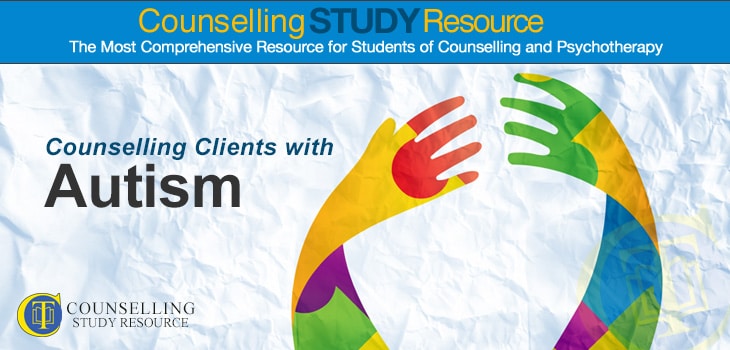Special Edition – Counselling Clients with Autism
During the UK academic breaks, Rory Lees-Oakes and Ken Kelly produce occasional special editions of the Counselling Tutor Podcast, in which they provide a ‘deep dive’ into a specific topic important to counselling and psychotherapy.
In this episode, Rory talks with Angela Maughan about her experiences with autism as both a counselling client and student counsellor. Angela also offers helpful information and insights to remember when counselling clients with autism.
Angela was diagnosed as having autism in her early 30s, and has a son who is autistic. Prior to her diagnosis, she experienced a range of mental-health services, including counselling.
She is now training to be a counsellor herself, with the aim of counselling autistic teenagers and adults. She runs a support group for people with autism in Gateshead in the UK.
Members of our Facebook group – which includes over 20,000 people (students, tutors and qualified counsellors) interested in the world of counselling and psychotherapy – were given the opportunity to suggest questions that Rory would put to Angela.
These show-notes summarise the points covered in the discussion on counselling clients with autism and are not a full transcript; please listen to the podcast itself to hear the detailed version.
Counselling Clients with Autism: Q & A Summary
Q: How would you describe yourself, in terms of your autism?
A: Different people prefer different ways. Personally, I say that I have autism, but some people prefer to say that they are autistic.
It is very much a personal preference – so please always ask the individual person about the language they would prefer you to use in referring to their autism.
Taking the time to do this can really help to build rapport at the start of the counselling relationship.
Q: What do you wish people understood about your condition?
A: Autism is a neurodevelopmental disorder: this means that our brains are wired differently from those of people who are neurotypical.
It can be very stressful to live with autism – everyday tasks that may seem easy for a neurotypical person often feel overwhelmingly complex for someone with autism.
It can affect our cognitive and executive functioning, meaning that we forget things and are more prone to accidents.
Because this can be really challenging, we are often good at masking our struggles – but this also involves a lot of extra effort and so can be really exhausting.
Q: Have you sought counselling mainly because of your autism and related issues or for other reasons?
A: Most of my counselling was before I was diagnosed as having autism.
I had been serially labelled with a range of other conditions, which led to me experiencing anxiety and low self-esteem. In fact, these are common comorbidities of autism – as are ADHD [attention deficit hyperactivity disorder], OCD [obsessive compulsive disorder], PTSD [post-traumatic stress disorder], epilepsy, pathological demand avoidance, chronic fatigue syndrome and fibromyalgia.
As well as epilepsy, PTSD and fibromyalgia, I myself also have migraine. Many of these conditions relate to the sensory overload and exhaustion that come with living with autism.
Q: Did you find it easy to connect with your counsellors or were there barriers to doing so?
A: I have had a range of types of counselling and counsellors, each with its own strengths but also frustrations.
CBT [cognitive behavioural therapy] was particularly frustrating – many people with autism struggle with the homework tasks for this.
This can lead to more anxiety – and I even had letters sent to my doctor by the therapist saying that I was being non-compliant.
I have also struggled with talking therapies when a phrase used is ambiguous (it takes a lot of effort for me to work out what the therapist means) – and when silence is used (it made me feel awkward and panicky, and so overwhelmed).
Q: How can counsellors be helpful to a client who has autism?
A: The most important thing is to build rapport.
Take the time to get to understand about their autism, how it affects them, what they need and what to do if they reach crisis point in the session.
Be open to the idea of using forms of communication other than words – for example, offer the opportunity to draw as a way of expressing emotions.
If you use silence in your work, then explain to the client at the start about this – how it works and its purpose.
Q: What does ‘crisis point’ look like and how can a therapist help?
A: It really means feeling overwhelmed in the session – having a sensory overload.
Visible signs to the therapist might be that the client begins to fidget or that their voice changes. They might even sound aggressive, without meaning to.
Another sign might be ‘stimming’ [e.g. hand-flapping, rocking, spinning, or repetition of words and phrases].
The therapist can help by noticing this and letting the client slow down or take a break from talking.
Useful activities can include using something soft and tactile (e.g. having a blanket in the session) for comfort, playing with lego or doing a puzzle.
I have also found writing a useful activity to help me identify my emotions – either on a whiteboard in the session or through journaling between sessions.
Q: Which modality of therapy has worked best for you?
A: I have tried quite a lot of different approaches, including CBT, person-centred therapy and DBT [dialectical behaviour therapy]. Each has had pros and cons really.
For example, not feeling judged is great in person-centred therapy (and such a contrast to much of life in the outside world for a person with autism), but the silences can be hard to handle.
DBT helped me with interpersonal relationships, but again I found the paperwork and homework heavy.
Overall, I have taken bits from each therapy that have worked for me, using an integrative approach.
Q: How many sessions have you typically had, and how have you found the beginnings and endings?
A: Generally, I’ve had eight, ten or twelve sessions.
The beginning was always hard. I often used scripted responses – in other words, I’d say I was fine when actually I was struggling.
One counsellor I had took extra time to really get to know me, even adding some extra sessions to the usual number to allow this, and that was amazing.
As for ending, it’s important to me to have time to prepare for this and not be taken by surprise. I think it’s really useful to remind the client each time what number session they are on and how many they’ve got left.
Q: How about the counselling environment: what would be comfortable or uncomfortable about a room?
A: It’s really important to me to have natural light: fluorescent light is unpleasant and overstimulating.
I feel vulnerable on a hard, upright chair – a soft seat or couch is much better. It also gives me something soft to touch (especially if there are cushions) if I start to feel the need to calm myself down.
I once was in a room where there was a salt lamp, which I really liked.
Having a student sitting in would be extremely anxiety-provoking (though I might not be able to tell you this, instead resorting to a scripted response).
And try to avoid change to the room: this is hard to cope with.
Q: What advice would you give to student counsellors?
A: Take the time to learn about the client, about how autism affects them, and about their interests and needs.
Consider doing some additional training to help you learn more about neurodiversity, so that you can relate better. Don’t rely on TV programmes to educate you!
Also, support the client to work on expressing their feelings, for example through drawing or using emotion cards.
Above all, remember that the therapeutic relationship is key.
We would like to thank Angela sincerely for sharing her experiences with us.


